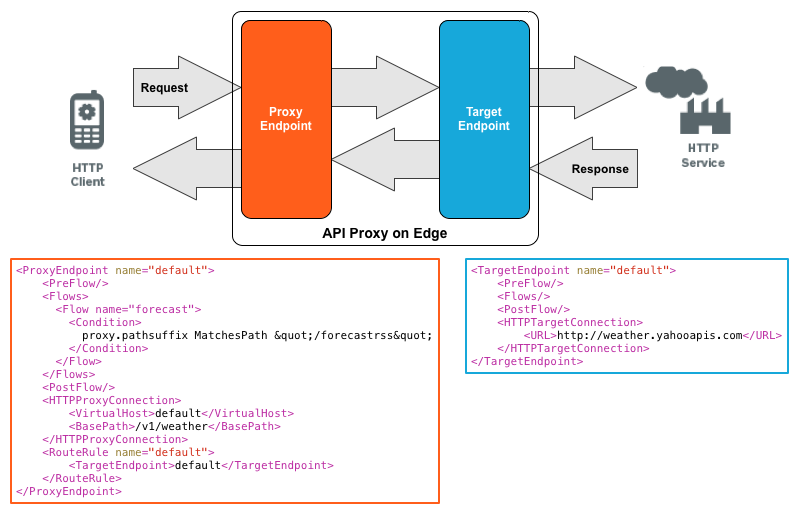You're viewing Apigee Edge documentation.
Go to the
Apigee X documentation. info
When you make a request to an API proxy, you can pass any or all of the following information, depending on the way the API proxy is configured:
- Request headers
- Query params
- Form data
- XML or JSON payloads
- Resource URIs
By default, all data in a request is passed unchanged from the ProxyEndpoint to the TargetEndpoint. Therefore, when the TargetEndpoint makes the request to the backend server, all information in the original request is passed to the backend service.
The same is true for the response received by Edge from the backend service. By default, all data received in the response is passed unchanged to the app that originated the request.
How is request data passed to the backend server?
The following image shows an API proxy definition:

For this API proxy:
- API proxy virtual host: "default"
- Domain defined by the virtual host: "http://myOrg-prod.apigee.net"
- Proxy base path: "/v1/weather"
- TargetEndpoint specified by route rule: "default"
- Target URL: "http://weather.yahooapis.com"
A client app makes a GET request to the API proxy by using the following
curl command:
curl -X GET http://myOrg-prod.apigee.net/v1/weather/forecastrss?w=12797282
Notice that this request contains the resource "forecastrss" and one query param,
w. Edge parses the request as
shown below and assigns parts of the request to flow variables:
{request.verb} {proxy.basepath}/{proxy.pathsuffix}?{request.querystring}The flow variables are set with the following values:
request.verb: "GET"proxy.basepath: "/v1/weather"proxy.pathsuffix: "forecastrss"request.querystring: "w=12797282"
The TargetEndpoint then makes a request to the backend service using information from the request:
{request.verb} {target.basepath}/{proxy.pathsuffix}?{request.querystring}Notice how the resource and query params specified in the request are automatically included in the request to the backend server. From the definition of the TargetEndpoint, the request then has the form:
curl -X GET http://weather.yahooapis.com/forecastrss?w=12797282
Like query params, any headers or form params that you include in the request to the API proxy are passed on to the backend server. For example, you make the request below that includes a header:
curl -X GET -H 'Content-type:application/xml' http://myOrg-prod.apigee.net/v1/weather/forecastrss?w=12797282
Or a request in the form below to include a header and form data:
curl -X POST -H "Content-type:application/json" -d \
'{"email" : "janetutorialxml@example.com",
"firstName" : "Jane",
"lastName" : "Tutorial",
"userName" : "jtutorialxml"
}' \
http://myOrg-prod.apigee.net/v1/register/user
In both examples, the headers and form data are passed unchanged to the backend service. The
headers are represented by flow variables such as request.headers.count and
request.headers.names. The form data is represented by flow variables such as
request.formparam.count and request.formparam.names.
How is response data returned?
By default, all data received by Edge from the backend service in the response is passed unchanged to the app that originated the request. As described above for the request, the data returned in the response is accessible through flow variables on Edge. For more information, see Flow variables reference.
Access request and response data in an API proxy
There are many times where you want to modify request data before sending it to the backend server. For example:
- To remove security information used by Edge to validate requests. That information is not required by the backend service.
- To add data sent to the backend service, for example to track users or to gather analytics.
- To conditionally process the request based on request data. For example, an API proxy can have multiple TargetEndpoints. The TargetEndpoint used by the request is determined by request data. You then strip that data from the request before sending it to the backend service.
The same is true for data in the response. As part of processing the response, the API proxy might want to modify the data before returning it to the requesting app.
Access request messages
You can use policies to access and change parts of a request message. These parts include:
- Headers
- Query parameters
- Form parameters
- Source IP address
- HTTP message body
In a normal flow, once the request has been processed, the proxy then sends the transformed request to the target.
Policies can examine request variables, then transform or reject the request based on the content of those variables. Policies transform the request by setting the appropriate variables, for example variables corresponding to the request headers.
Access response messages
Using the variables that apply to the response message, policies may access message components including the header, the query parameters, and form parameters, the source IP address, the HTTP message body, and so on.
The proxy receives a response message, then applies to it a series of policies, based on conditions evaluated on the response, which can modify or transform the response.
Policies can examine response variables, then transform or reject the request based on the content of those variables. Policies transform the response by setting the appropriate variables, for example variables corresponding to the response headers.
Common policies to access flow variables
Edge defines several policies that you can use to process the request and response data. These policies include:
- AssignMessage policy: Creates or modifies HTTP request or response messages during an API proxy flow. Also creates and populates new flow variables.
- ExtractVariables policy: Extract content from messages, including headers, URI paths, payloads, and query parameters, for use in a condition statement. The policy then applies a text pattern to message content and upon finding a match sets a designated variable.
- JSONtoXML policy and XMLtoJSON policy: Converts messages from JavaScript Object Notation (JSON) to the extensible markup language (XML) format, or vice versa.
- JavaCallout policy, JavaScript policy, PythonScript policy, RegularExpressionProtection policy: These policies let you write a script to access flow variables containing request and response data.
